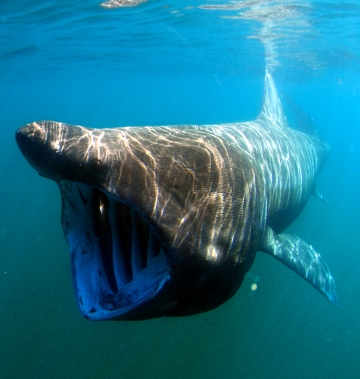701123_Warm-Blooded Fish_360 px width.jpg

Basking sharks, like the one seen here, are the second largest fish and have the ability to warm their bodies. Credit: Greg Skomal, NOAA Fisheries Service.
The basking shark looks intimidating. It’s the second largest of all fish—it’s 25 feet or longer and can weigh 10,000 pounds. And it can open its jaw a yard wide—wide enough to swallow a person. Yet the shark is a gentle giant. It cruises through the ocean at a leisurely two or three miles per hour, filtering tiny organisms from the water—nothing for swimmers to fear.
Yet researchers recently found that the basking shark shares one trait with some of its more fearsome cousins, such as the great white: it’s warm-blooded. While the body temperature of most fish matches the temperature of the water, the basking shark stays several degrees warmer than its environment.
Warm-blooded fish are rare—they account for just one in a thousand species. Most of them are fast swimmers and big-time predators. The list includes several species of shark and tuna, plus a few others. Only one fish is considered fully warm-blooded: opah, a large, flat fish found in the deep ocean around the world.
Warm-blooded fish keep warm through a unique arrangement of blood vessels. Blood in the vessels near the gills is chilled by the ocean water. But those vessels pass by others that are carrying warm blood. That heats the cold blood, which is then pumped throughout the body.
In all warm-blooded species, the heat warms their muscles, stomachs, and brains and eyes. That allows them to swim, digest their food, and react much faster than other fish—big advantages in the cold ocean depths.

